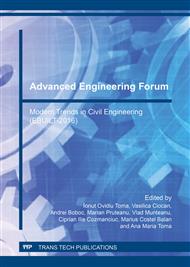p.190
p.196
p.207
p.213
p.219
p.226
p.234
p.242
p.249
Fiber-Reinforced Mortar Incorporating Pig Hair
Abstract:
Recycled fibers from food-industry could be added as reinforcement to cement-based materials. Cement-based materials perform well under compression, but tensile strength and post-cracking ductility in tension are poor. Fibers produced from steel, glass and synthetic materials, have been successfully used to overcome some of these shortcomings. Fiber-reinforced mortar has shown an increased post-cracking ductility and improved long-term serviceability due to the crack control provided by fibers. Food-industry waste disposal is globally a major concern because of its environmental impacts. For these reasons, the use of recycled materials in construction applications has been investigated over the last decades. This investigation deals with the incorporation of pig hair, which is a waste produced by the food-industry worldwide, in fiber-reinforced mortars. This composite material is intended to reduce the environmental impacts by valuing waste materials in construction applications while improving mechanical properties. To determine compressive, flexural and impact strength, bulk density, porosity and dynamic modulus of elasticity laboratory tests were conducted in mortar specimens with 0%, and 2% of pig-hair content in weight of cement. The results of this research show that the impact strength can increase up to five times when compared to plain mortar. Moreover, the compressive and flexural strengths, bulk density, porosity and the dynamic modulus of elasticity of fiber-reinforced mortar, with the aforementioned pig-hair content, are not significantly affected.
Info:
Periodical:
Pages:
219-225
Citation:
Online since:
March 2017
Price:
Сopyright:
© 2017 Trans Tech Publications Ltd. All Rights Reserved
Share:
Citation:


